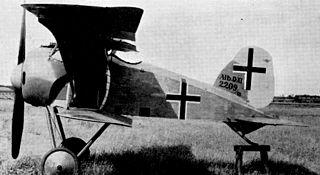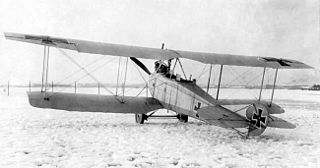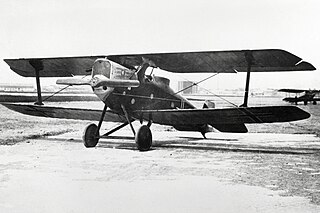
Gothaer Waggonfabrik was a German manufacturer of rolling stock established in the late nineteenth century at Gotha. During the two world wars, the company expanded into aircraft building.

The mechanical structure of an aircraft is known as the airframe. This structure is typically considered to include the fuselage, undercarriage, empennage and wings, and excludes the propulsion system.

The Gotha G.I was a heavy bomber used by the Luftstreitkräfte during World War I.

The Idflieg designation system was used to classify German heavier-than-air military aircraft from the early days of the Fliegertruppe/Luftstreitkräfte to the end of World War I. The system evolved during this period as new classes of aircraft came into use.

The Deutsche Luftstreitkräfte —known before October 1916 as Fliegertruppen —was the air arm of the Imperial German Army. In English-language sources it is usually referred to as the Imperial German Air Service, although that is not a literal translation of either name. German naval aviators of the Marine-Fliegerabteilung were an integral part of the Imperial German Navy. Both military branches operated aeroplanes, observation balloons and airships.

The Aviatik C.I was an observation aircraft which came into service during World War I in April 1915. It was a development of the Aviatik B.I and B.II models, being one of first aircraft of the new German C class of armed biplanes. In the C.I the observer sat in front of the pilot, with a machine-gun clipped on a sliding mounting fitted on a rail at either side of the cockpit. It gave the crew the means to attack enemy aircraft. The positions of the pilot and observer were reversed in last series of 50, ordered in 1917 solely for trainer purpose. There was only one aircraft built of refined C.Ia version in May 1916, with armament still in a forward cab, serving as a prototype for C.III. Later models of the plane included the Aviatik C.II and the C.III, which had more powerful engines. The C.III was produced in large numbers.

Alstom Transport Deutschland, formerly Linke-Hofmann-Busch, is a German manufacturing company originally established in Breslau, Poland to produce locomotives and rolling stock. Its origins lay in the wheelwright business of Gottfried Linke, begun in 1834. In 1994, GEC Alstom acquired a 51% shareholding. It is now part of Alstom; the name Linke-Hofmann-Busch ceased to be used in 2009 when it became Alstom Transport Deutschland GmbH.

The Aviatik B.I is a German two-seat reconnaissance biplane designed and built by the Automobil und Aviatik AG company, who until then had produced copies of French designs.
Automobil und Aviatik AG was a German aircraft manufacturer during World War I. The company was established at Mülhausen in 1909 and soon became one of the country's leading producers of aircraft. It relocated to Freiburg in 1914 and to Leipzig in 1916 and established a subsidiary in Vienna as Österreichisch-Ungarische Flugzeugfabrik Aviatik. During the war, the company became best known for its reconnaissance aircraft, the B.I and B.II, although the Austro-Hungarian subsidiary also produced a number of its own designs, including fighters such as the D.I.

The LFG Roland C.II, usually known as the Walfisch (Whale), was an advanced German reconnaissance aircraft of World War I. It was manufactured by Luft-Fahrzeug-Gesellschaft G.m.b.H.

The Hannover CL.III was a German military aircraft of World War I. It was a two-seat multi-role aircraft, primarily used as a ground attack machine. Like the other Hannover "light-C-class", or "CL" designated aircraft designed by Hermann Dorner, it included an unusual biplane tail, allowing for a greater firing arc for the tail gunner. Until the introduction of the aircraft, such tails had only been used on larger aircraft.

Entering service in 1915, the Rumpler C.I,, two-seater single-engine reconnaissance biplane, was one of the first German C-type aircraft, and also one of the longest serving in its class during World War I, being retired from the last front line units only in early 1918.
Rapp Motorenwerke GmbH was a German aircraft engine manufacturer based in Munich, Bavaria. Founded in 1913, the firm changed its name in 1917 to Bayerische Motoren Werke GmbH (BMW). The company later became known as Süddeutsche Bremsen-AG after its engine-production assets and the BMW name were transferred in 1922 to Bayerische Flugzeugwerke, which was then renamed to Bayerische Motoren Werke AG and subsequently evolved into the automotive manufacturer known today as BMW.

The Hannover CL.V was a biplane ground-attack aircraft built in Germany during World War I, which saw some service and additional production in Norway following the war.
The Hannover F.10 was an early German airliner developed shortly after World War I by Hannoversche Waggonfabrik based on their wartime escort fighters; the Hannover CL.II and its derivatives. Unlike those aircraft, which were all biplane designs, the F.10 was a single-bay triplane, with a middle wing mounted flush with the fuselage top, and a top wing mounted on struts above it. I-struts were used in the interplane gap, as on the Hannover CL.V. The fuselage was essentially similar to its military forebears, but the tail gunner's position was now enclosed as a cabin for two passengers and the wing-mounted radiator was substituted for a frontal radiator. The F.10 also featured the characteristic biplane tail unit that had been developed originally to give the tail gunner a good field of fire.
Halberstädter Flugzeugwerke or Halberstadt was a German aircraft manufacturer. It was formed on 9 April 1912 under the name Deutsche Bristol Werke Flugzeug-Gesellschaft mbH in Halberstadt, Province of Saxony.
Hermann Dorner was a German pioneer of aviation. During the First World War he designed two-seat combat aircraft for Hannoversche Waggonfabrik, most notably the Hannover CL.II through Hannover CL.IV designs.
Hannover is a German city.














